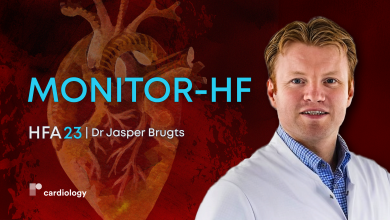Search results
Author(s):
Stuart D Katz
Added:
3 years ago
A recent study reported the clinical characteristics and outcomes of 43 non-edematous ambulatory patients with congestive heart failure, in whom clinical volume status was categorized by a direct measurement of blood volume by a radioisotope technique.1 Despite on-going treatment with high doses of loop diuretics and few physical signs of congestion, 65% of the subjects in this cohort were found…
View more
Author(s):
Mitchell T Saltzberg
Added:
3 years ago
Volume Overload in Heart Failure
The burden of heart failure (HF) remains formidable in the US, with nearly one million annual hospital admissions and frequent outpatient visits to a variety of care providers.1 While HF outcomes have improved modestly over the past several decades, many patients still struggle to maintain a satisfactory quality of life.2 Implantable cardioverter–defibrillators…
View more
Author(s):
Jasper J Brugts
Added:
11 months ago
ESC-HFA 2023 — Dr Jasper Brugts (Thoraxcenter, NL) joins us to outline the findings and summarise the take-home messages from the MONITOR-HF trial (NTR7672).
MONITOR-HF was an open-label, randomised trial, done in 25 centres in the Netherlands. Eligible patients had chronic heart failure of New York Heart Association class III and a previous heart failure hospitalisation, irrespective of…
View more
Author(s):
Maria Rosa Costanzo
Added:
3 years ago
In the US, 90% of the one million annual hospitalizations for heart failure (HF) are due to volume overload.1,2 Hypervolemia contributes to HF progression and mortality. Guidelines recommend that therapy for HF patients be aimed at achieving euvolemia. Intravenous loop diuretics induce rapid diuresis that reduces lung congestion and dyspnea. However, the effectiveness of loop diuretics declines…
View more
Author(s):
Hossein-Ardeschir Ghofrani
,
Ralph T Schermuly
,
Norbert Weissmann
,
et al
Added:
3 years ago
Pulmonary arterial hypertension (PAH) has an estimated prevalence of 15–25 cases/million population.1 This chronic, progressive disease is defined by a mean pulmonary arterial pressure >25mmHg in conjunction with normal pulmonary capillary wedge pressure <15mmHg.2 The disease is characterized by increased vascular resistance of the pulmonary microvasculature, ultimately resulting in right…
View more
Author(s):
Rebecca L Attridge
,
Rebecca D Moote
,
Deborah J Levine
Added:
3 years ago
Pulmonary hypertension is classified into five groups by the World Health Organization (WHO). Group 1, pulmonary arterial hypertension (PAH), is a progressive disease characterized by an elevation in pulmonary arterial pressure and pulmonary vascular resistance that may progress to right heart dysfunction and failure.1 PAH is defined as a mean pulmonary artery pressure (mPAP) ≥25 mmHg at rest,…
View more
Author(s):
Karthiek R Narala
,
Thomas A LaLonde
,
Sohail Hassan
,
et al
Added:
3 years ago
Chronic kidney disease (CKD) affects approximately 26 million people in the US.1 CKD is considered a coronary risk equivalent and also a risk factor for progression of cardiovascular disease (CVD).2 Cardiovascular death rates are 10–30 times higher in dialysis patients than in the general population.3 This increase in CKD patients is multifactorial and is now mainly considered via two pathways:…
View more









